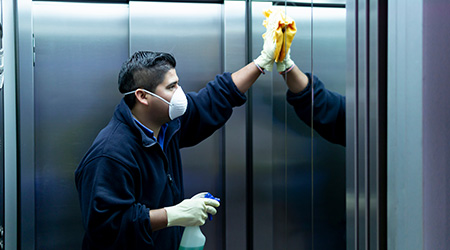Why Facilities Professionals Should Care About Cleaning Protocols
Cleaning expert Steve Ashkin previews his NFMT 2022 session: Facilities professionals should aim to clean to disinfect while also keeping employees safe.
Interest in commercial cleaning is at an all-time high as the COVID-19 pandemic continues. Facilities managers are now tasked with determining what the best cleaning protocols are in order to create a safe and healthy environment. However, some products can create other health concerns that will need to be addressed in the future.
At NFMT, Steve Ashkin, president, The Ashkin Group, will discuss how facilities managers can reach the goal of cleaning to disinfect while keeping employees safe in his session A Deep Dive into Healthy Cleaning Protocols: Why FMs Should Care.
FacilitiesNet: Why is it essential that facilities managers make routine cleaning a priority?
Ashkin: The science is clear that indoor environmental quality can directly affect health and occupants' performance, plus research indicates that occupants expect their buildings to be clean. Furthermore, cleaning is one of the largest costs from an operational perspective and thus it is essential that routine cleaning be a priority and is appropriately managed to generate the best return on the investment.
FN: What are some of the dangers that surround failing to have a cleaning protocol?
Ashkin: From a management perspective, without being too dramatic, but the reality is that if we fail to follow proper cleaning protocols with the appropriate commitment of resources – occupants’ lives are literally at risk of harm and potentially death. This is especially true in high-risk facilities such as healthcare, long-term care, food production, food service, pharmaceutical manufacturing, prisons and other building types. This is also important within other building types if they have restaurants, breakrooms, nurse’s offices (e.g., in schools) and other areas where pathogens and other contaminants can be passed amongst occupants. And beyond the health issue, cleaning is often required by law or code, and even routine janitorial is one of the areas that if done poorly, will lead to substantial dissatisfaction and complaints to facility managers from occupants.
FN: How has cleaning strategies changed since the COVID-19 pandemic first began?
Ashkin: There are a number of lessons-learned from COVID:
- It reminded us how important cleaning is AND we must remember that airborne contaminants such as the SARS CoV 2 virus is just one of the contaminants of concern. Remember when we used to be concerned about mold, lead dust. E. coli, staph, salmonella and other contaminants – but these other contaminants remain a concern in addition to airborne pathogens.
- Product selection such as for disinfectant products is important AND that we have numerous options including those products that are “green” – safer for human health and the environment.
- Cleaning and disinfection should focus on high-touch surfaces which are those that are frequently touched by multiple people throughout the day (e.g., a door knob or light switch is only considered a high-touch surface if multiple people touch it throughout the day).
- Concentrated disinfectants and other products must be diluted properly AND dilution control devices should be checked for accurate performance.
- Cleaning performance should be measured AND we have technology (e.g., ATP meters) that can be used to objectively measure performance.
- Workers must be properly trained as cleaning is primarily a labor related issue AND training is incredibly important as we should anticipate labor shortages over the short term.
- Occupants are concerned about their health and facility managers should provide them with information explaining what the facility is doing to protect their health.
FN: What are some of the environmental impacts of cleaning products? What should facilities managers keep in mind when choosing products?
Ashkin: The professional cleaning industry consumes:
- 6 billion pounds of chemicals each year, many of which are hazardous to human health and the environment and made from non-renewable natural resources.
- 4.5 billion pounds of sanitary paper products (e.g., toilet tissue and paper hand towels) which are frequently made from virgin tree fiber requiring the cutting of some 27 million trees directly affecting our forest ecosystems and climate change.
- 35 billion trash bags are used each year which is 95 million bags per day! Most are made from virgin plastic resins that are made from natural gas a nonrenewable natural resource.
Today, facility managers have numerous options that are third-party certified to reduce adverse impacts on both health and the environment, perform well, and are cost competitive when compared conventional products.
FN: What will NFMT attendees gain from your session?
Ashkin: Beyond science, this session will provide specific recommendations to make it easy to select and use greener cleaning products. The recommendations are not brand specific, but rather rely on widely accepted green building programs such as LEED and WELL, and the third-party certifications so that purchasers can buy with confidence.
Mackenna Moralez is assistant editor, facility group.
Related Topics:












